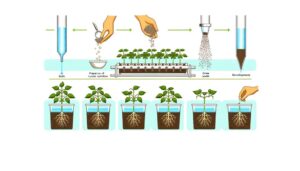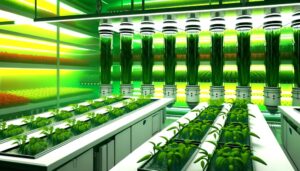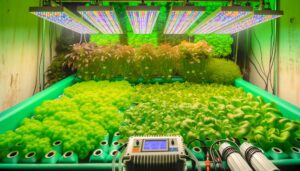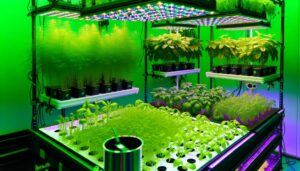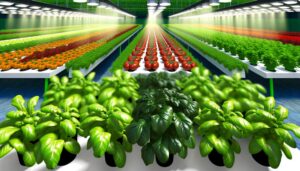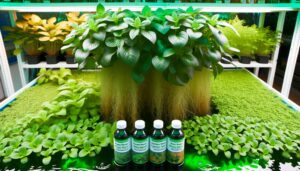Successful Hydroponic Farming in India
Hydroponic farming in India has gained momentum due to its significant benefits over traditional agriculture, including a 30% higher crop yield per unit area and up to 90% less water usage. Research initiated in the 1960s by IARI showed positive outcomes, promoting its viability in arid regions.
Advances in nutrient management and climate control technology have further enhanced productivity. Systems like Nutrient Film Technique and Deep Water Culture boost efficiency, while suitable crops such as lettuce, basil, and tomatoes promise high returns.
Case studies from Maharashtra and Bangalore highlight increased yield and water savings. Explore more to understand its transformative impact.
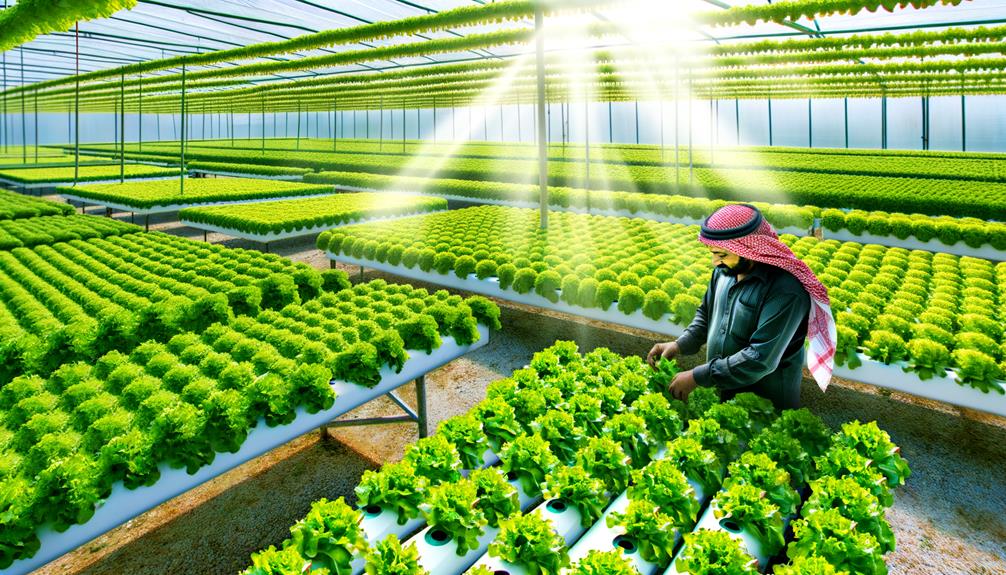
Key Takeaways
- Hydroponics in India can produce up to 30% more crops per unit area using 90% less water.
- Popular systems like NFT, DWC, and Aeroponics enhance growth rates and minimize water usage.
- Essential equipment includes automated nutrient delivery systems, LED grow lights, and advanced climate control technology.
- Suitable crops for hydroponics include leafy greens, herbs, tomatoes, cucumbers, and strawberries.
Origins of Hydroponics in India
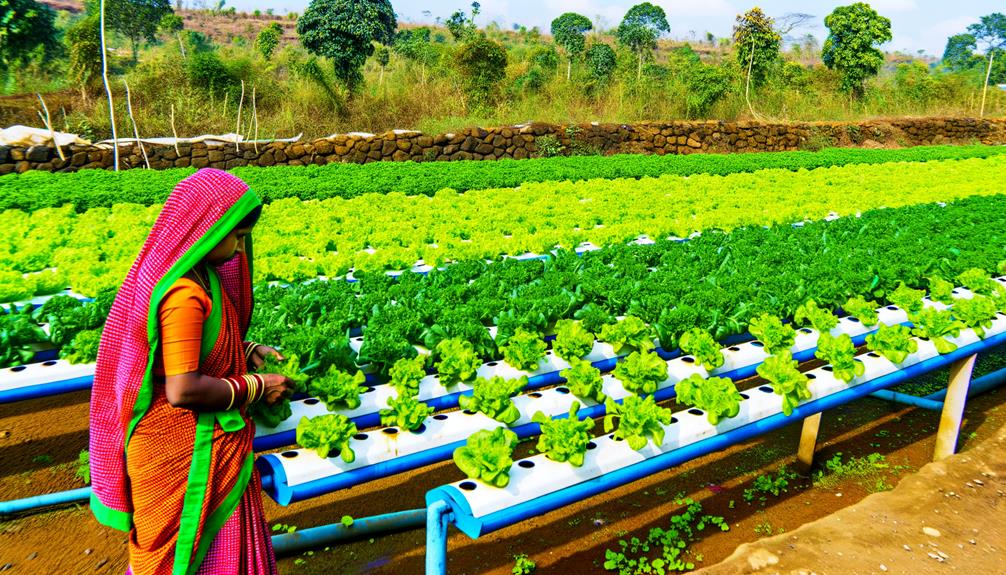
The origins of hydroponics in India can be traced back to early experimental research conducted in the mid-20th century by agricultural scientists seeking innovative solutions to the country's food production challenges.
Initial studies focused on understanding nutrient uptake efficiency and water conservation, essential for India's agrarian landscape.
By the 1960s, research led by institutions such as the Indian Agricultural Research Institute (IARI) showcased promising results, particularly in regions with arid and semi-arid climates.
Data from these early experiments indicated a potential increase in yield by 20-30% compared to traditional soil-based farming.
Such findings underscored the viability of hydroponics as a method to enhance crop productivity, thereby laying the foundation for its gradual adoption in Indian agriculture.
Key Benefits
Hydroponic farming offers several key benefits, including considerably higher yield potential and efficient resource utilization, as evidenced by numerous studies. Data indicates that hydroponic systems can produce up to 30% more crops per unit area compared to traditional soil-based agriculture. Further, hydroponics uses up to 90% less water, a critical advantage in water-scarce regions.
| Benefit | Data |
|---|---|
| Yield Potential | Up to 30% higher than traditional farming |
| Water Usage | Utilizes up to 90% less water |
| Pesticide Usage | markedly reduced, promoting healthier crops |
Moreover, the controlled environment minimizes the need for pesticides, leading to safer and more nutritious produce. These benefits illustrate the transformative potential of hydroponics in addressing food security challenges in India.
Popular Hydroponic Systems
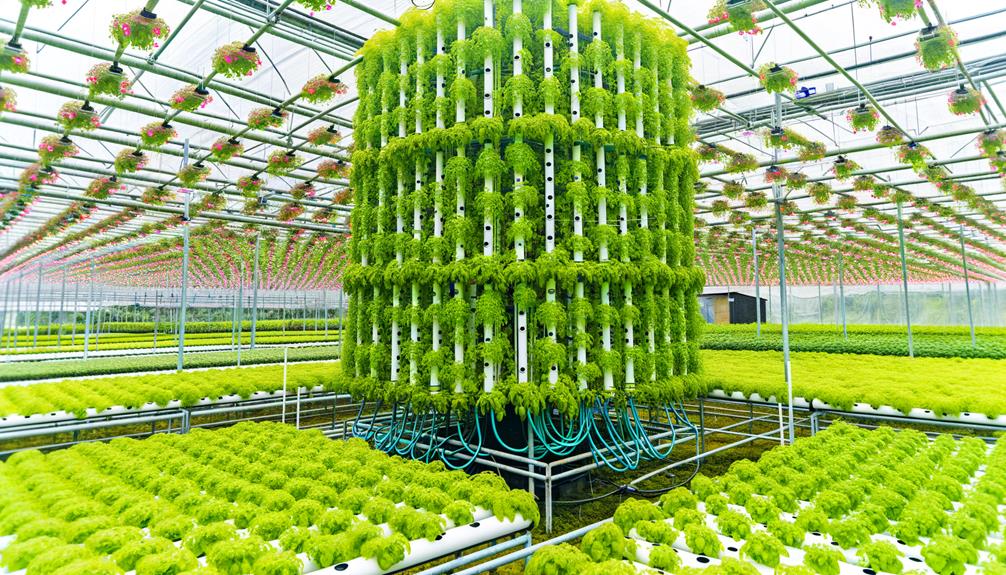
The adoption of hydroponic farming in India has led to the proliferation of various systems, among which the Nutrient Film Technique (NFT), Deep Water Culture (DWC), and Aeroponic systems are the most prevalent.
Research indicates that NFT is favored for its efficient use of water and nutrients, while DWC is noted for its simplicity and high yield potential.
Aeroponic systems, although more technologically intensive, offer superior oxygenation and faster growth rates, making them an attractive option for advanced cultivators.
Nutrient Film Technique
Nutrient Film Technique (NFT), a widely adopted hydroponic system, utilizes a continuous, shallow stream of nutrient-rich water to nourish plant roots, enhancing growth efficiency and yield. This innovative method offers numerous advantages, substantiated by research and empirical data:
- Increased Productivity: NFT systems can yield up to 30% more crops compared to traditional soil farming, maximizing space and resources.
- Water Efficiency: Studies indicate that NFT uses 90% less water than conventional agriculture, a vital benefit in water-scarce regions.
- Nutrient Management: Precise control over nutrient supply reduces waste and guarantees ideal plant health.
- Scalability: NFT systems are highly adaptable, making them suitable for both small-scale urban setups and large commercial operations.
These factors collectively underscore NFT's potential in revolutionizing hydroponic farming in India.
Deep Water Culture
How does Deep Water Culture (DWC) stand out among popular hydroponic systems regarding efficiency and simplicity of design? DWC systems excel due to their straightforward setup and operational efficiency. Research indicates that DWC can increase growth rates by 15-25% compared to traditional soil farming. The continuous oxygenation and nutrient-rich environment foster ideal plant health, making it an appealing choice for innovators.
| Feature | DWC Advantages |
|---|---|
| Simplicity | Easy to set up and maintain |
| Growth Rate | 15-25% faster than soil farming |
| Resource Efficiency | Lower water usage compared to soil |
| Plant Health | Enhanced due to constant oxygenation |
| Cost | Lower initial investment |
Such attributes position DWC as a highly efficient and economical solution for hydroponic farming in India.
Aeroponic Systems
Among the spectrum of hydroponic systems, aeroponic systems leverage advanced technology to maximize plant growth and resource efficiency. Aeroponic systems elevate plant cultivation by suspending roots in air and misting them with nutrient-rich solutions. This method guarantees ideal oxygenation and nutrient absorption, leading to faster growth rates and higher yields.
Research indicates that aeroponic systems can reduce water usage by up to 98%, energy consumption by 60%, and pesticide use by 100%.
Key benefits of aeroponic systems include:
- Unmatched Growth Rates: Accelerates plant growth by 25% compared to traditional soil farming.
- Resource Efficiency: Utilizes 95% less water and 60% less energy.
- Disease Reduction: Minimizes exposure to soil-borne diseases.
- Scalability: Ideal for vertical farming and urban agriculture.
Embracing this innovation can revolutionize Indian agriculture.
Essential Equipment
For successful hydroponic farming in India, selecting the right essential equipment is pivotal, encompassing nutrient delivery systems, grow lights, and climate control technology.
According to recent studies, efficient nutrient delivery systems can enhance crop yield by up to 40%, while appropriate grow lights can greatly impact plant growth cycles.
Additionally, advanced climate control technology can mitigate the risks associated with fluctuating environmental conditions, ensuring a stable growing environment.
Nutrient Delivery Systems
The efficiency of hydroponic farming in India heavily relies on the precision and reliability of nutrient delivery systems, which are crucial for enhancing plant health and yield.
Properly calibrated systems guarantee that plants receive the exact nutrients they need, minimizing waste and maximizing growth potential. Research indicates that automated nutrient delivery systems can increase crop yields by up to 25%.
Key components include:
- Nutrient Reservoirs: Fundamental for storing nutrient solutions, guaranteeing a steady supply.
- Pumps and Timers: Critical for maintaining consistent nutrient flow and precise timing.
- Drip Emitters and Sprayers: Allow for targeted nutrient delivery, reducing excess use.
- pH and EC Meters: Essential for monitoring nutrient solution quality, guaranteeing ideal absorption.
These advancements are revolutionizing India's agricultural sector.
Grow Lights Selection
Selecting appropriate grow lights is critical for maximizing plant photosynthesis and achieving high yields in hydroponic farming systems.
Research indicates that LED grow lights are the most energy-efficient, with a Photosynthetic Photon Flux (PPF) efficiency of 2.7 µmol/J, surpassing traditional HPS and fluorescent lights.
A study by the Indian Agricultural Research Institute highlights that red and blue spectrum LEDs enhance vegetative growth and flowering by 25% compared to conventional lighting.
Additionally, a 2021 survey found that hydroponic farms utilizing full-spectrum LEDs experienced a 30% increase in yield per square meter.
When selecting grow lights, consider the specific light spectrum, intensity, and energy consumption to guarantee peak plant growth and economic efficiency.
Climate Control Technology
Efficient climate control technology is indispensable for maintaining ideal growing conditions in hydroponic farming systems, directly impacting plant health and yield. Advanced systems guarantee peak temperature, humidity, and CO2 levels, fostering robust plant growth and maximizing productivity. Research indicates that precise climate control can enhance crop yields by up to 30%.
Critical components of climate control technology include:
- Temperature Regulation Systems: Maintain consistent temperatures for peak metabolic rates.
- Humidity Control Units: Prevent fungal diseases and promote healthy transpiration.
- CO2 Enrichment Systems: Boost photosynthesis, accelerating plant growth.
- Ventilation and Air Circulation: Guarantee even distribution of air and prevent hotspots.
Investing in these technologies is essential for hydroponic farmers aiming to achieve superior crop quality and sustainable yields.
Suitable Crops

Identifying suitable crops for hydroponic farming in India requires a careful analysis of crop compatibility with hydroponic systems, local market demand, and climatic conditions.
Research indicates that leafy greens such as lettuce, spinach, and kale have high compatibility due to their rapid growth cycles and low nutrient demands.
Additionally, herbs like basil and mint show promising yields in hydroponic setups.
According to market data, tomatoes and cucumbers are also viable, driven by their consistent market demand.
Studies highlight that strawberries, with their high market value, are increasingly being adopted by Indian hydroponic farmers.
This data-driven approach guarantees that crop selection aligns with both agronomic suitability and economic viability, fostering sustainable and profitable hydroponic farming practices in India.
Water Management
Proper water management is paramount in hydroponic farming, guaranteeing ideal nutrient delivery and plant health, especially when cultivating crops like leafy greens, herbs, and strawberries that thrive in controlled environments.
Data-driven strategies reveal that enhancing water usage can lead to up to 90% water savings compared to traditional soil farming.
Key factors to take into account include:
- Water Quality: Utilize purified or treated water to avoid contaminants that could disrupt plant growth.
- pH Levels: Maintain pH levels between 5.5 and 6.5 to guarantee nutrient solubility and uptake.
- Water Recycling: Implement closed-loop systems to reuse water efficiently, reducing waste.
- Monitoring Systems: Employ real-time monitoring systems for continuous assessment and adjustment of water parameters to maintain optimal conditions.
These strategies are critical for maximizing yield and sustainability.
Nutrient Solutions
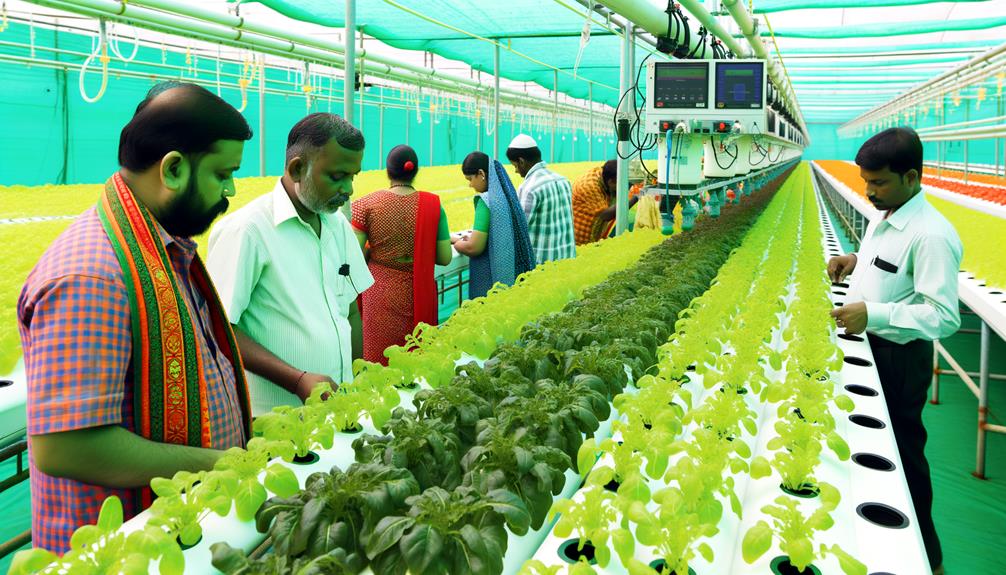
Understanding the composition and management of nutrient solutions is vital for optimizing hydroponic farming in India.
Research indicates that the precise mixing of essential nutrient components, coupled with regular monitoring of solution pH, directly impacts plant health and yield.
Analytical data from various studies highlight the importance of maintaining balanced nutrient levels to achieve sustainable and productive hydroponic systems.
Essential Nutrient Components
The success of hydroponic farming hinges on the precise formulation and management of nutrient solutions, which supply plants with essential macro and micronutrients necessary for ideal growth.
Research indicates that optimal nutrient compositions enhance plant health and yield considerably.
Essential components include:
- Macronutrients: Nitrogen, phosphorus, and potassium are critical for plant growth, impacting processes like photosynthesis and energy transfer.
- Secondary Nutrients: Calcium, magnesium, and sulfur play crucial roles in cell structure, chlorophyll production, and enzyme activation.
- Micronutrients: Iron, manganese, zinc, copper, molybdenum, and boron are required in trace amounts but are indispensable for metabolic functions.
- Water Quality: High purity and appropriate pH levels guarantee efficient nutrient absorption and minimize potential toxicity.
Strategically balancing these elements fosters robust plant development and maximizes agricultural output.
Mixing Nutrient Solutions
Accurate mixing of nutrient solutions is critical to guaranteeing that plants receive the precise balance of nutrients necessary for ideal growth and development.
Research indicates that optimal nutrient concentrations directly influence plant health, yield, and quality. For instance, a study conducted by the Indian Agricultural Research Institute revealed that a meticulously balanced nutrient solution can enhance crop yield by up to 30%.
Advanced hydroponic systems employ automated dosing units to achieve precision in nutrient delivery, reducing human error. Innovators in the field utilize real-time data analytics and IoT-enabled sensors to monitor and adjust nutrient levels dynamically.
These technologies guarantee that each plant receives tailored nutrition, fostering robust growth and maximizing productivity within controlled environments.
Monitoring Solution Ph
Maintaining the perfect pH level in nutrient solutions is critical for nutrient uptake efficiency, as research from the University of Agricultural Sciences in Bangalore indicates that even slight deviations can greatly impair plant growth and health.
Ideal pH levels generally range from 5.5 to 6.5, and constant monitoring guarantees that plants receive the precise nutrients needed for robust growth. Technological advancements have enabled more accurate pH measurement and adjustment, considerably benefiting hydroponic farmers.
Consider the following key points:
- Enhanced Plant Growth: Ideal pH levels maximize nutrient absorption.
- Cost Efficiency: Proper pH management reduces nutrient waste.
- Disease Prevention: Balanced pH levels minimize pathogen proliferation.
- Yield Improvement: Consistent pH increases overall crop yield and quality.
These factors underscore the importance of precise pH management in hydroponic systems.
Light and Temperature Control
Effective light and temperature control in hydroponic farming directly impacts plant growth and yield, necessitating a thorough understanding of environmental requirements and technological solutions.
Research indicates that ideal light intensity, spectrum, and photoperiod greatly influence photosynthesis rates and plant morphology.
LED grow lights, preferred for their energy efficiency and customizable spectrum, have shown to enhance growth by 20% compared to traditional lighting.
Temperature regulation, maintaining an ideal range of 20-25°C for most crops, is vital for metabolic processes and stress reduction.
Advanced climate control systems, incorporating sensors and automated adjustments, guarantee consistent environmental conditions.
Data from hydroponic farms in India reveal that precise light and temperature management can increase productivity by up to 30%, underscoring its essential role in successful cultivation.
Urban Hydroponics
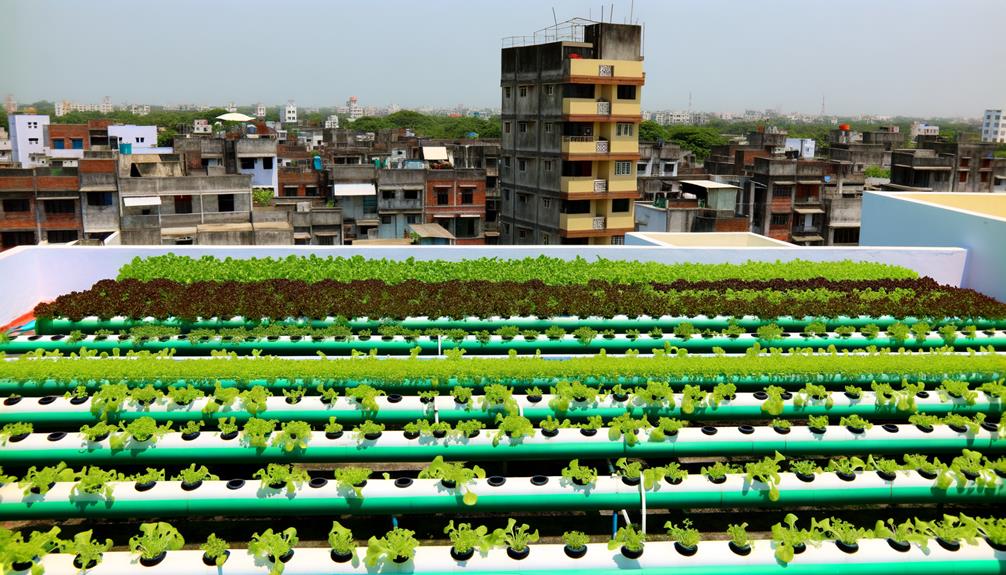
Building on the critical role of light and temperature control, urban hydroponics presents a viable solution to address space constraints and food security challenges in densely populated cities.
Research indicates that urban hydroponics can yield up to 90% more produce per square meter compared to traditional farming techniques. This innovative method leverages vertical farming, efficient water usage, and nutrient recycling to maximize output.
The following data points illustrate the transformative potential of urban hydroponics:
- 90% Water Savings: Hydroponics uses considerably less water than soil-based agriculture.
- Increased Yield: Vertical farming can produce up to 10 times more food per unit area.
- Reduced Carbon Footprint: Localized production minimizes transportation emissions.
- Year-Round Growth: Controlled environments guarantee uninterrupted crop cycles.
Urban hydroponics therefore emerges as a compelling strategy for sustainable urban agriculture.
Case Studies
Several case studies from various regions in India illustrate the practical applications and benefits of hydroponic farming systems. These systems have enabled farmers to cultivate crops in controlled environments, leading to higher yields and reduced water consumption. Many agricultural institutes and startups now offer programs where individuals can learn hydroponic farming in India and adopt this innovative technique. As awareness grows, more farmers are transitioning to hydroponics to overcome soil degradation challenges and ensure sustainable food production.
For instance, a study in Maharashtra reported a 30% increase in yield and a 40% reduction in water usage compared to traditional soil-based farming.
In Bangalore, a commercial hydroponic farm demonstrated a 50% faster crop cycle, enhancing market responsiveness.
Research in Punjab highlighted the system's resilience against soil-borne diseases, reducing the need for chemical pesticides by 60%.
Data from these studies underscore the efficiency and sustainability of hydroponics, with measurable improvements in productivity and resource management.
These findings reinforce the potential of hydroponics to revolutionize Indian agriculture, offering robust alternatives to conventional practices.
Future Prospects
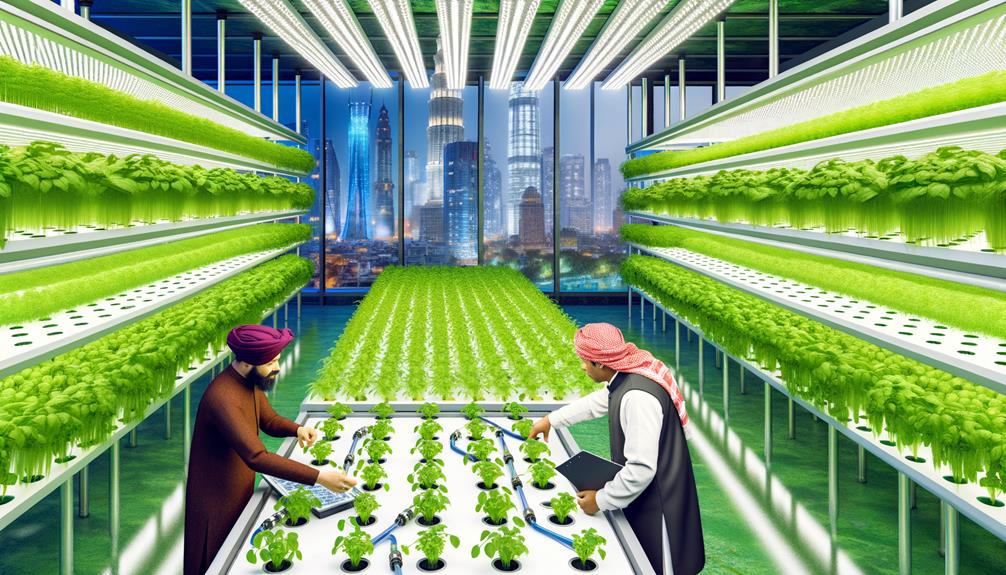
Given the demonstrated efficiency and sustainability of hydroponic farming systems from various case studies, future prospects for this innovative agricultural method in India appear promising, with potential advancements in technology and policy support poised to further enhance its adoption and impact.
The following factors could drive this growth:
- Technological Innovations: Integration of IoT and AI to optimize nutrient delivery and crop monitoring.
- Government Policies: Increased subsidies and incentives for hydroponic setups to encourage farmers.
- Market Demand: Rising consumer preference for pesticide-free, locally-grown produce.
- Environmental Concerns: Growing awareness about water conservation and reduced land use.
These elements, backed by empirical data, suggest a robust trajectory for hydroponic farming in India, fostering both economic growth and sustainable agriculture.
Conclusion
The trajectory of hydroponic farming in India mirrors the innovative spirit of ancient agricultural practices, yet it is firmly rooted in modern scientific advancements.
The integration of technology, ideal resource utilization, and adaptability to urban environments underscores its potential.
As the practice gains momentum, it promises to address food security and sustainability challenges.
Future research and investment will be pivotal in realizing its full potential, making hydroponic farming a cornerstone of India's agricultural evolution.

